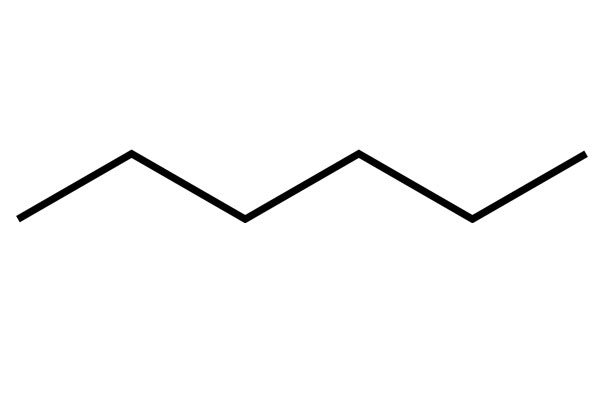Cas No: 110-54-3
EINESC No: 925-292-5
Molecular weight: 86.178 g/mol
Chemical Formula: C6H14
Chemical Structure:
Physical Properties
General Properties: colorless liquid
Odor: oil-like
Intensity: 0,6606 g/mL (20 ° C)
Boiling point: 140-200 °C
Melting point: −95 °C
Flash point: 69 °C
Vapor pressure: 16,167 kPa (20 ° C)
Refraction index: 1.375 (20 ° C)
Solubility (aqueous) 9,5 mg/L
Viscosity:

General Properties
Hexane is a hydrocarbon that has 6-carboned linear chain. It is an important ingredient for oil. It is commonly used as apolar solvent in industry due to its low cost and easy-to-vaporize properties. Hexane is usually sold as 65% hexane and hexane isomers. The reason for this is the high cost of hexane purification. In industry, hexane is not always needed to be in pure form.
Production
Hexane is produced by distillation of pure oil.
Applications
Hexane has a wide range of uses in industry. It is mosty used as solvent for dyes and thinners. It is used in plastic, gum, resin, rubber, ink and disinfectant. The glues used in shoe production usually contain hexane.
It was used to remove oil from fibres in textile business but its usage is now restricted.
It also Works as a apolar volatile solvent for certain lab technics such as chromatography.
Safety Measures and Toxic Values
Hexane exposure in high doses may lead to acute nausea, vertigo and head ache. It can also damage neural system in higher concentrations. In chronic exposure, it may lead to permanent damage in central nervous system and internal organs. It is also extremely irritant for eyes and skin. Hexane is suspected to be hazardous to fertility.
Hexane is extremely dangerous to aquatic environments. It is insoluble in water and it cumulates in it.
It is also extremely flammable. In 1981, it was illegally released in sewage and caused a fire that spread for 21 kilometers.
Hexane must be stored in cool, well-aired environments. It must be kept away from fire sources at all times. It must never be given to city network.